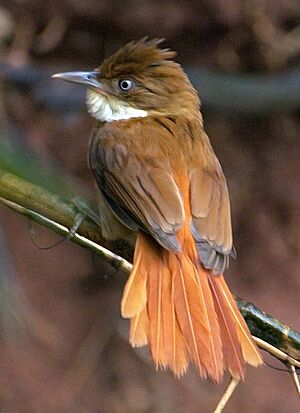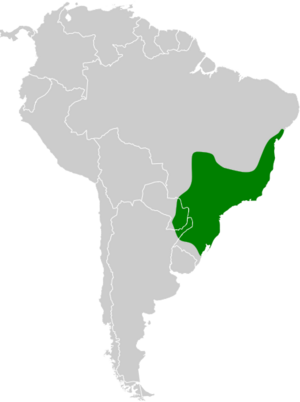White-eyed foliage-gleaner facts for kids
Quick facts for kids White-eyed foliage-gleaner |
|
|---|---|
 |
|
| Conservation status | |
| Scientific classification | |
| Genus: |
Automolus
|
| Species: |
leucophthalmus
|
 |
|
The white-eyed foliage-gleaner (Automolus leucophthalmus) is a type of bird that lives in forests. It belongs to the ovenbird family, called Furnariidae. You can find this bird in Argentina, Brazil, and Paraguay. It gets its name from its whitish eyes.
Contents
About This Bird's Family
Scientists group birds into families and species. The white-eyed foliage-gleaner is part of the ovenbird family. There are two main types, or "subspecies," of the white-eyed foliage-gleaner. They are named A. l. leucophthalmus and A. l. sulphurascens. Another bird, the Pernambuco foliage-gleaner, used to be considered a type of white-eyed foliage-gleaner. But in 2008, scientists decided it was different enough to be its own species.
What Does It Look Like?
The white-eyed foliage-gleaner is a medium-sized bird. It is about 18 to 20 centimeters (7 to 8 inches) long. It weighs between 25 and 38 grams (0.9 to 1.3 ounces). Both male and female birds look the same.
Its face is dark brownish with faint reddish lines. It has a white area under its eyes and a dark reddish-brown head. Its back and rump are dark reddish-brown. Its tail is a bright reddish-orange color. The wings are also reddish-orange.
Its throat and neck sides are white. The middle of its chest is white, turning to a light yellow on its belly. The sides of its body are a reddish-brown. Its eyes are whitish. Its beak is brownish to black on top and greenish-gray on the bottom. Its legs and feet are grayish.
Young birds look a bit different. Their head and back are more evenly colored. Their chest and belly are slightly darker.
Where Does It Live?
One type of this bird, A. l. leucophthalmus, lives only in eastern Brazil. The other type, A. l. sulphurascens, lives in a larger area. This includes south-central and southeastern Brazil, eastern Paraguay, and northeastern Argentina.
These birds like to live in tropical evergreen forests. They also live in older secondary forests, which are forests that have grown back after being cut down. They can be found from sea level up to about 1,000 meters (3,300 feet) high. Sometimes, they are found even higher, up to 1,400 meters (4,600 feet).
Bird Behavior
Movement
The white-eyed foliage-gleaner does not migrate. It stays in the same area all year long.
What It Eats
This bird eats many different kinds of bugs. It also eats snails sometimes. It often looks for food with other bird species in a mixed-species feeding flock. It usually stays low in the forest, hiding in thick plants. It finds its food by picking bugs from dead leaves, fallen branches, and plants growing on trees. Sometimes, it looks for food in bamboo patches.
Life Cycle
Scientists believe these birds lay eggs in the spring and summer. This is usually from September to December. They are thought to stay with one partner.
The bird builds a cup-shaped nest. It uses plant stems and leaf parts. The nest is placed at the end of a tunnel. The bird digs this tunnel in an earthen bank. A female bird usually lays three or four eggs. We don't know how long the eggs take to hatch. We also don't know how long it takes for the young birds to leave the nest.
What It Sounds Like
The white-eyed foliage-gleaner's song is a fast, rhythmic sound. It sounds like a liquid or grating "tlewtlew---". Its call is a high, sharp, nasal "itew". It also makes single "kwek" calls and double "kwek-kwaah" calls.
Status and Protection
The IUCN (International Union for Conservation of Nature) says the white-eyed foliage-gleaner is of "Least Concern." This means it is not currently in danger of disappearing. It lives in a large area. However, the number of these birds is not known and is thought to be going down.
No immediate big threats have been found for this bird. It is found in several protected areas. Large areas of its forest home have been cut down. But the bird can still live in small forest pieces. It also seems to do well in forests that are growing back. However, one type of this bird, the A. l. leucophthalmus subspecies, is only found in a few places. It might need more protection.


